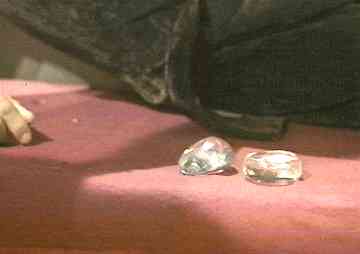
In Shadow
A state with a form of government vesting the supreme authority in a single person, or the form of government itself. Monarchies developed independently on the various continents of Earth. Most appear to have begun with some form of election, the succession later becoming hereditary, usually by male primogeniture. In many states, the monarch was seen as possessing some form of religious significance, as seen in the doctrine of divine right, where the monarch's right to rule was based on divine sanction.
By the late twentieth century, most Earth monarchies had become 'limited', with the monarch's powers being limited by constitutions, elected legislatures, and governments. In such cases, these monarchs were viewed as neutral symbols of the state.
In the B7 universe, five monarchies were seen, bearing some resemblance to those in Earth history:
1. Cygnus Alpha: The first monarchy encountered in the series was that of Vargas on Cygnus Alpha. It was a theocratic monarchy, the state governed by a priestly order, with their deity's laws regarded as the laws of the state. Heading the order, and worshipped as the representative of the deity, was Vargas. He was a hereditary monarch, directly descended 'by the true and chosen line' from his great-great-grandfather, who founded a religion to unite the prisoners, therefore 'Mine is the power by right'. He was also an absolute monarch, telling Blake that 'I am the supreme power here. My word is law. My followers obey without question'.
2. Horizon: Ro's monarchy on Horizon. He said that 'I rule this planet' and was referred to as the ruler, although his rule was nominal, due to the Federation. Like Vargas, he was a hereditary monarch, having succeeded his father, Movo. He also posessed what, by twentieth century Earth standards, would be regarded as the usual monarchical trappings of a palace with a throne room.
3. The Keeper: Gola's monarchy on Goth. This was the first monarchy where the ruler's title was known, Gola being Charl of the Goths. It was also the first monarchy for which familiar twentieth century terms were used, Vila addressing Gola as king, and the adjective 'royal' being applied to the latter and his family. While the succession was hereditary it was also somewhat uncertain, with no primogeniture; because the previous Charl, Gola's father, was deposed by him and his brother Rod, who quarreled over the succession. As the result of a plot by their sister, Tara, both brothers died, leaving the way clear for her to succeed. Like Ro, Gola posessed what appeared to be a throne.
4. Aftermath: Chel's monarchy on Sarren. Apart from him being the leader of the Sarrens, we know nothing of his monarchy.
5. Power: Gunn-Sar's monarchy on Xenon. His title was Lord (or Chief) of (all) the Hommiks. He ruled by 'right of challenge', as well as 'by the strength of my right arm and by my left arm', having killed his predecessor, Mavarik, in single combat. His right to rule was based on this and on his continued success in dealing with any challengers; instead of a line of ancestors, he had a 'tally of challenges': 25 dead and 1 missing. Also, before starting his fight with Avon, Gunn-Sar said that when he dies 'the victor is lord'. Presumably, a high tally of challenges would deter many would-be challengers until the Lord grew sufficiently old and feeble, explaining why Mavarik remained in power until 63 years of age.
Of the five monarchies, three of the monarchs had titles. Regarding the succession, three monarchies were hereditary - although that of Goth was more uncertain - while that of the Hommiks was based on the 'right of challenge'.
See also CHEL, GOLA, GUNN-SAR, RO, ROD, TARA, VARGAS.
Most references were to the Credit as a unit of currency, but the vem was also in use in the 6th Quadrant and possibly elsewhere. The actual form that money took was rarely seen: in Shadow Blake used precious stones in his attempt to buy Largo's services. In Gold Keiller made a reference to "computer link-up", suggesting that most credit transfer was by computer, although the Federation and others used bullion for some payment with frontier planets. Servalan paid ten billion credits for the gold stolen from the Space Princess, and this was given in bank notes of what appeared to be one million credit denomination. This was Zerok local currency and rendered worthless by Zerok joining the Federation. Indeed, the stolen gold's cited value of "seventeen billion" may well have been in Zerok currency rather than the Federation Credit. Many other worlds presumably had their own local currency and exchange rates. In Aftermath Avon mentioned "considerable sums of various currencies" in the strongroom on Liberator.
|
The use of precious stones and jewellery for barter and the abundance of such
things in Liberator's strongroom, implies that cash might well have
been rare, and that most legal transactions involved computerised credit
transfer. It is not impossible that cash may have been illegal in some
societies.
|  In Shadow |
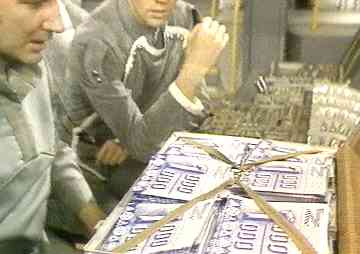 |
Apart from the bank notes in Gold, the only money seen would appear to
be in Gambit, where Krantor was paid by Servalan with small, brown,
rectangular plaques, presumably representing credits. They may have been a
form of cash, but more likely some form of computerised credit, perhaps
untraceable to their owner. No denomination was given, but presumably fairly
high since Avon and Vila could comfortably carry their ten million credits in
two small boxes. Interestingly enough, the money Servalan paid Krantor for
Travis (presumably four million credits) also fitted in two small boxes.
|
|
Horizon was one of only two planets known to have a rich seam of
monopasium-239, a radioactive substance which the Federation needed for their
hyperspace ships. The mineral was extracted by slave labour, Ro noting that
"only 10% of the workers die" and that they were "primitives" anyway. A
lethal dose could be absorbed in 30 "time units". Mined ore was collected
annually by Federation freighter. Mining operations presumably ceased when
the Federation personnel on the planet were wiped out and Ro restored as a
ruler in his own right.
| 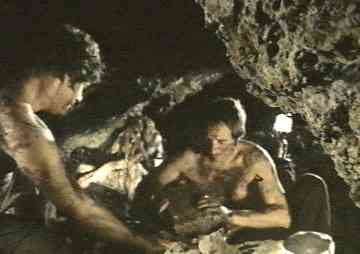 Blake and Vila mining monopasium-239 |
The only monorail mentioned was on Helotrix, and that had been in disuse for about a century. Hunda planned to enter the city through the monorail tunnel, which was then promptly set with charges after Leitz informed the General of Hunda's plans. Dayna and Tarrant discovered Leitz's treachery, and Hunda entered by another route. The charges were blown and the monorail tunnel destroyed.
|
Native to Zonda, described by Zen as species Alpha 7/5, "a xerophyte of the
genus Corla", which Avon took to mean "a cactus!". They were collected to
near-extinction, prized for their partial telepathy and ability to move.
They also provided the raw material for the addictive drug shadow. Moon
Discs avoided direct sunlight, and kept in the shadows, hence the name of the
drug. The Federation, under the guise of the Terra Nostra, harvested Moon
Discs on Zonda, supplying them with shade. Some if not all of these
plantations were destroyed by Blake in one of Liberator's rare uses of
its surface strike capability. Whether this rendered the species truly
extinct is unclear: Blake said that it "won't hurt [the President] much, but
it'll sting a bit", but this is rather vague. Avon suggested that Moon Discs
in the plantations were collected from deep desert. The plantations were
protected by the President's personal security force.
| 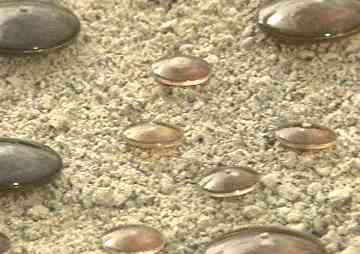 |
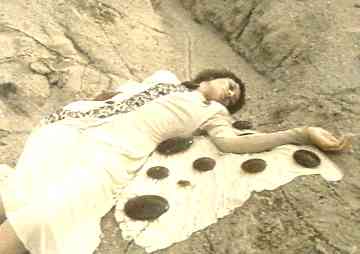 | Cally, telepathically isolated by the Darkness, was given enough strength by the Moon Discs to overcome her loneliness and deactivate Orac by telekinesis. She took a Moon Disc back with her to Liberator (although she was not seen to be carrying one when she teleported aboard). Moon Discs normally died when taken from their native planet, but Cally told Avon that "you have to talk to them". This specimen was never seen again. |
A patient admitted to the Central Clinic on Earth on the same day as the three children Blake supposedly assaulted.
|
Worked for Justice Department on Earth, and was prosecuting counsel at
Blake's trial. Unlike Varon, standing for the defence, she was well aware of
the way the evidence against Blake had been manufactured, being the one who
had suggested doing so in the first place.
| 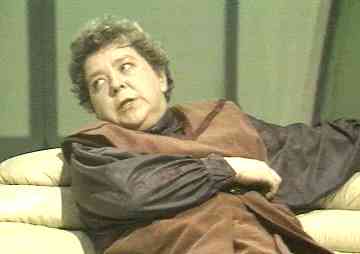 |
| Federation officer under Servalan's command after the Intergalactic War. His rank was never specified. She offered to make him her Supreme Commander if he succeeded in taking Liberator. Mori and his men landed on Obsidian, killed Milus and Natin on Servalan's command, took Dayna and Tarrant prisoner (he was refrained from killing them by Bershar), and then teleported aboard the Liberator. Cally was taken back to Obsidian as a hostage, along with Orac,and held prisoner on the edge of the volcano. | 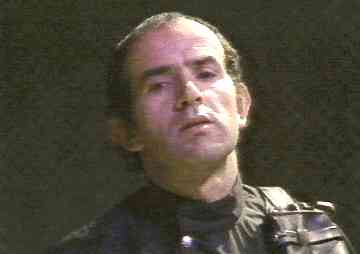 |
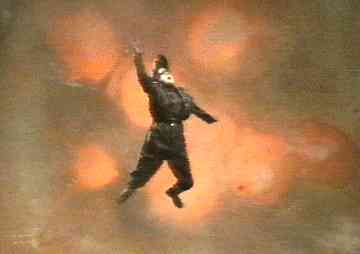 |
Mori died when the blast from a grenade thrown by Dayna hurled him into the
active volcano's crater.
|
When Avon returned to the Liberator after the Intergalactic War, Zen informed him that Jenna was on a neutral cargo ship headed towards Morphenniel. No more was heard of Jenna until Blake told Tarrant of her death on Gauda Prime.
Nickname for the Royal Canadian Mounted Police (RCMP). That force was founded in 1873 AD as the North-West Mounted Police, to bring the authority of the new Dominion of Canada to the latter's newly acquired North-West Territories. The NWMP was given the 'Royal' prefix in 1904 by King Edward VII; and, in February 1920, it absorbed the Dominion Police, then responsible for policing in eastern Canada, was renamed the Royal Canadian Mounted Police, and became Canada's national police force.
On Earth in the twentieth century, the 'Mounties' became the one of the most distinctive Canadian institutions, recognisable due to their ceremonial uniform, particularly the red jacket and wide, flat-brimmed Stetson hat. The red jacket, based on the standard British military pattern, was used to differentiate the NWMP from the blue US military uniforms of that period.
It appears from Orbit that this distinctive red jacket ensured the continuing survival of the 'Mountie' nickname. In the episode, Vila speculated that using the Tachyon Funnel against the Federation, they could have 'whatever we want'. Among the things he wanted were a bodyguard of 'a thousand handpicked virgins in red fur uniforms', whom he would call 'Vila's Royal Mounties'.
See also this link to the RCMP's official website: